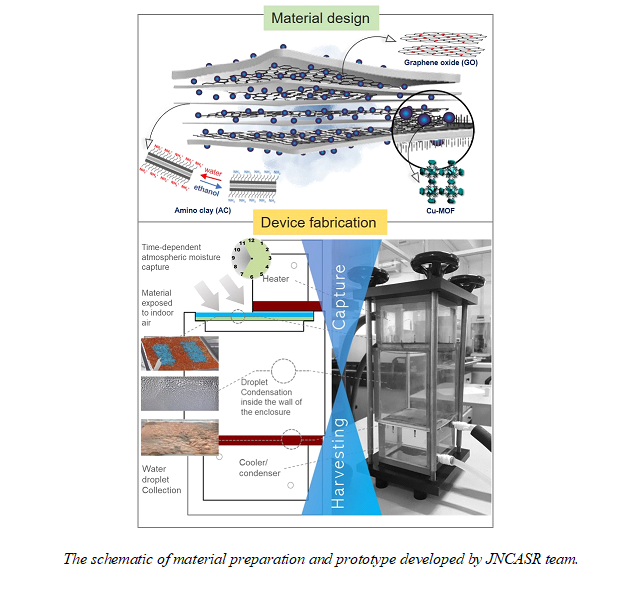A new device that can extract water from air can be used for indoor water harvesting from the atmosphere.
Water is the most indispensable natural resource separating life and death. Unfortunately, two-thirds of the global population lives under a modest water crisis, and it is expected that by 2050 half of the global population will face severe water scarcity. Atmospheric water generation could potentially meet the global water crisis as it holds about 13000 trillion litres of water (in the form of vapor and droplets) at any certain time. Commercially available atmospheric water harvesters are mostly functional beyond 60-70% relative humidity and commonly suffer from issues like water condensation and regeneration.
In the recent past, a few commercial and novel materials have been employed as a potential desiccant. However, so far, all have been tested in the arid region to exhibit threshold water uptake at low humidity and solar energy utilization in a more energy-efficient way. But the problem remains as the crisis is not limited to a geographic location. It subsequently depends on population, industrialization, climate change, water pollution, and so many other factors. Thus, it is essentially required to design a prototype assisted by such material that could potentially perform anywhere, anytime in a wide range of RH.
Given this, researchers from the Jawaharlal Nehru Centre for Advanced Scientific Research (JNCASR), an autonomous institute of the Department of Science and Technology (DST), have devised a prototype that can extract water from the air.

The prototype was named Indoor Atmospheric Water Harvester (IAWH), which employed a kind of material called Metal-Organic Framework (MOF) nano-composites. It consists of empty pores for adsorbing water molecules exactly like a sponge. The technology relies on a copper-based material connected through organic linkers. It has a design involving a linker-and-node set producing a cage-like framework. Such material has been further modified through two-dimensional templates (graphene oxide/GO and aminopropyl-functionalized magnesium phyllosilicate/AC) to provide additional openings for water molecules and improve hydrothermal resilience. It is postulated that the water molecules initially enter the pore that acts as a ‘seed water’ to attract the next water molecules leading to high-water storage capacity under extremely humid conditions. Experiments reveal the water harvesting performance of 0.431 gg−1 (gram of water harvested per gram of material) of water at 90% relative humidity with a maximum value of 0.445 gg−1 indoor (40-65%) water collection per day. The research was published in Advanced Functional Materials (Wiley-VCH, Germany).
While previously designed devices for the same purpose are mostly operational through interfacial solar heating, often used in arid or desert regions, awfully restricted by climatic constrain, this device is portable and can be used in indoor conditions assisted by usual electric input under any humid condition (10-90% RH) with low regeneration temperature.
The scientists have further extrapolated the water collection dynamics by varying ambient humidity, release temperature, and on-demand sorption/desorption cycle under the ordinary indoor condition without any solar irradiation.
The device's major component, Cu-MOF, has been stabilized on two templates that add multiple benefits to the resultant composite. At one end, it helps in downsizing bulk MOF towards MOF nanoparticles resulting in higher porosity leading to enhanced water uptake capacity. Secondly, it gains additional interfacial void space with hydrophilic functional groups (amine, epoxy, hydroxyl, carboxyl GO) from 2D matrices, which makes the water sorption thermodynamically and kinetically favourable. Thirdly, the composite unveiled improved moisture and thermal sustainability, making it more durable and efficient for water release. Finally, the material is cheap to prepare and shows distinguishable colour reversal, while the device is portable, stand-alone, and globally viable.
The future goal of the research team is to tune the water sorption for contemporary usage, i.e., dehumidification, adsorptive heating, and cooling technologies. They are extending their work for direct atmospheric air capturing, especially moisture and carbon dioxide, to mitigate the issues with indoor and outdoor air quality.
Publication link:
https://onlinelibrary.wiley.com/doi/full/10.1002/adfm.202203093
For more details, contact Prof. Tapas Kumar Maji, Email: tmaji[at]jncasr[dot]ac[dot]in






























